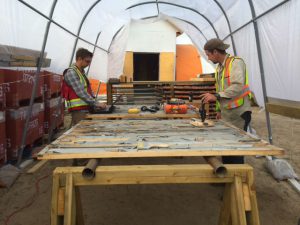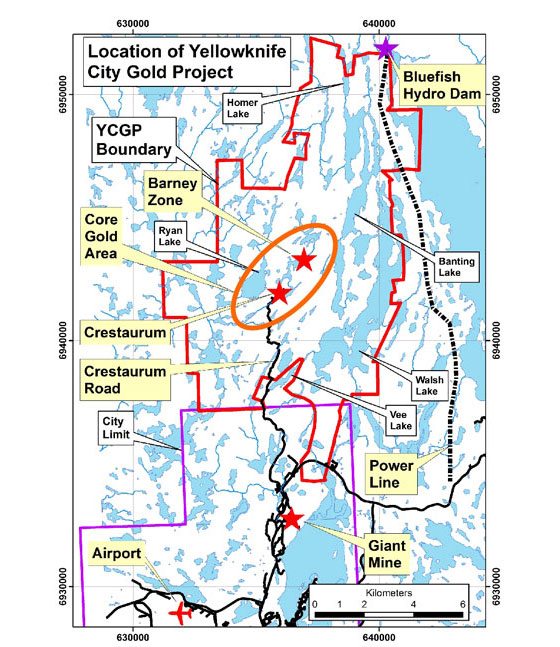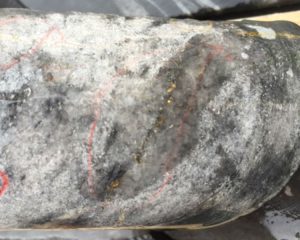Joe Campbell has been involved with various gold and base metal mines across Canada for over 35 years, but it’s the land around Yellowknife that he’s focused on now.
As the president, CEO and director of TerraX Minerals, Campbell oversees the exploration company that operates two projects in Canada – one on the Burin Peninsula of Newfoundland and a much larger project in Yellowknife, known as the Yellowknife City Gold Project.
Campbell says the company’s biggest focus is the project in Yellowknife, because of the history of mining in the town and because of encouraging drill results in recent years.

“Almost all of the big mine developments over the last several years have occurred in forming mining areas,” said Campbell. “Yellowknife has been ignored in that way, at least for the last 20 years.”
Roughly 50 people are now working in Yellowknife for the city gold project, with a second drill recently added to help increase drill tests.
The exploration company has already invested millions of dollars, with the project half way through its projected timeline.
“We’ve put about $13 million into the project already,” said Campbell. “We’re well financed well into 2017 to do as much exploration as we can logistically carry out.”

The work involves clearing any trees or bush so technicians can carry out surface exploration. Once test sections are bored, the cores (or pieces of rock) are brought to a facility on a piece of property at the Yellowknife airport.
There, geologists use special equipment to prepare the cores for inspection, as some may be broken or too brittle to be used. The cores are cut in half so a flat, inside surface is exposed which is ideal for geologists when inspecting.
The team looks for specific signs that could indicate the potential for gold, particularly what are known as “veins” that indicate mineralization.
“What we look for here is the quartz veins, the primary source of the gold,” said Campbell. “We also look for sulfide and alteration minerals, where we can see the platy fabric and the yellowy colour.”
The city gold project covers over 129 square kilometres of contiguous land within the Yellowknife Gold Belt.
So far, the company says they’ve had success “in finding new gold deposits,” though it remains to be seen if it’ll be high enough.
It wouldn’t be the first discovery of mineable gold for Campbell, as he helped discover the Maliadine gold project in Nunavut as project manager, and a 250 million tonne Nickel laterite deposit in Cuba while chief geologist.
In Yellowknife, Campbell has a clear goal: to open another gold mine.
“We think it’s a great opportunity to find another gold mine,” said Campbell. “The ultimate target here is to find a deposit that is actually mineable.”
LONG PROCESS
Should TerraX find high grade deposits, it would likely be another company that would be involved with actual mining, as bigger companies usually take over such projects once its worth is proven.
Though millions of dollars are being spent now, it could be decades before anything is mined.

“The most disappointing thing for people is when you talk of the timeline,” said Campbell. “These projects can take decades, but this project has an advantage because of the infrastructure around Yellowknife.”
An example of that can be seen at the company’s airport property, which contains shelving units with core tests dating back to the 1970s.
Such shelving units are important for exploration, because it allows geologists to map out the various tests and their results.
Because exploration for mining can take so long and because it has so much uncertainty, the company doesn’t employ anyone directly. Rather, contractors are hired to allow for financial freedom. Even Campbell doesn’t take a salary.
“It doesn’t have any direct employees at all,” said Campbell. “We can turn them on or off as the work requires and that allows us to preserve as much money as possible.”
TOXIC LEGACY NOT FORGOTTEN
Campbell was quick to bring up Giant Mine’s toxic legacy, which opened in 1948 amid much different regulations..
Today, companies are required to submit applications just to test rock deposits.
“The biggest difference is the regulatory regime that has been put in place,” Campbell said. “Even for a rather low-key exploration development, we’re well-regulated as to what we can do.”
Besides government regulations, Campbell says the company has carried out water and soil tests and has participated in studies surrounding Giant.
For the company, it’s in their interest to pay attention to the environment, Campbell says, because arsenic is a common element in the rocks around Yellowknife.
“It’s an issue Yellowknife has to deal with – one of the highest levels naturally in Canada,” said Campbell. “But that’s not unique, many gold projects deal with arsenic.”




